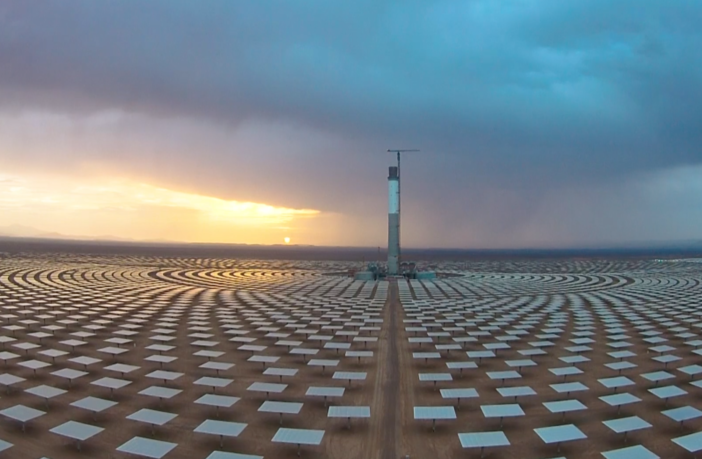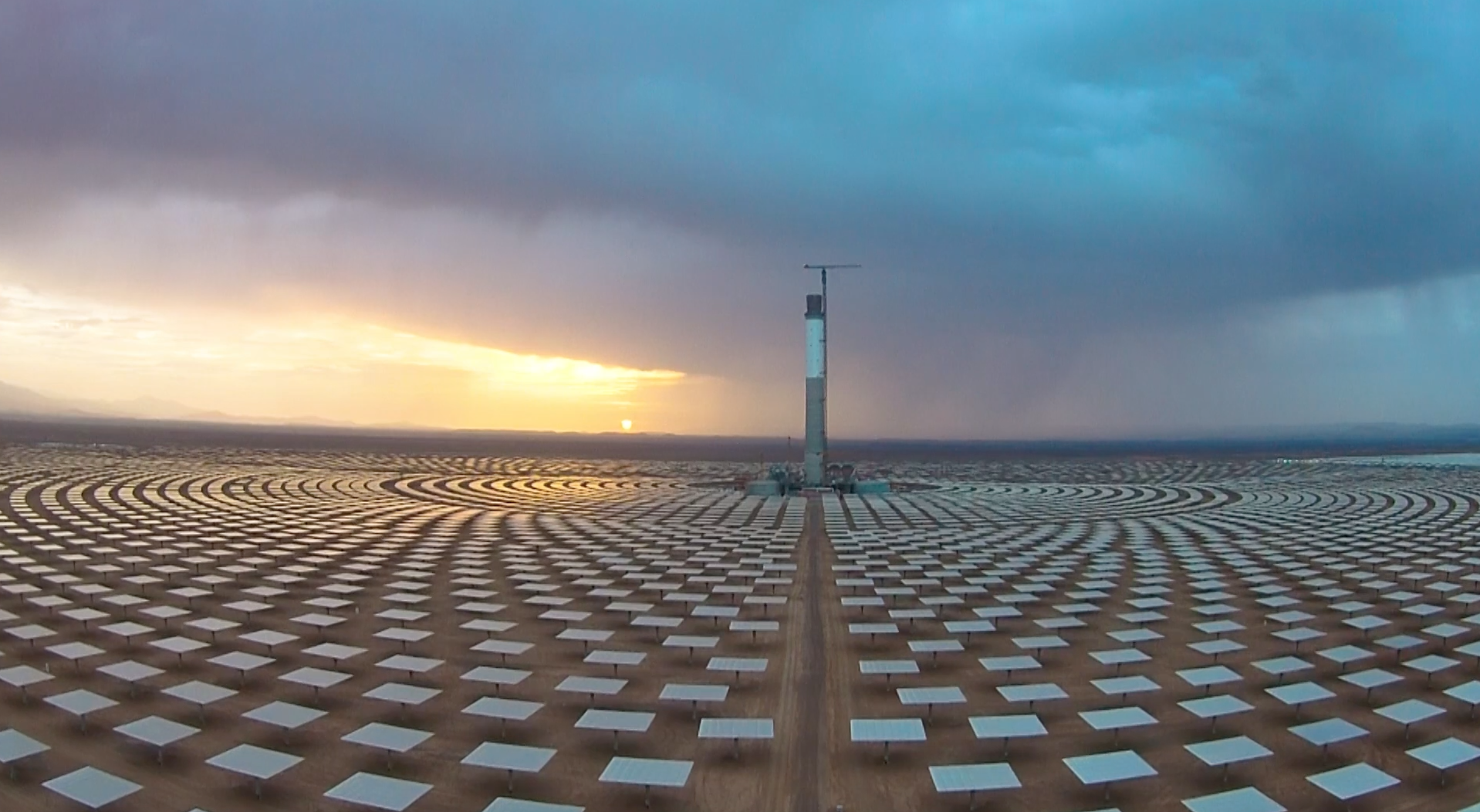PBS News Hour
Judy Woodruff
Morocco says it wants to be the Saudi Arabia of solar energy. Its flagship project is a first-of-its-kind, $9-billion energy plant called Noor, meaning “light” in Arabic, and the size of the city of Paris. Special correspondent Monica Villamizar reports from the city of Ouarzazate.
Judy Woodruff:
Next, we turn to Morocco, home to the largest solar energy plant in the world.
Today, the planet Earth meets over 80 percent of its energy needs with either coal, oil or gas. But as climate science and breakthrough technology disrupt the energy sector, Morocco is taking advantage of an abundant natural resource, unobstructed sunlight, to power part of the North African nation.
Special correspondent Monica Villamizar looks at a giant $9 billion project.
It’s part of our ongoing series, Peril and Promise, on the challenge of climate change.
Monica Villamizar:
Glimmering in the Sahara Desert, a first-of-its-kind solar energy plant.
Noor, which means light in Arabic, is so vast, it can be seen from space. From the air, it’s an ocean of reflective mirrors, but on the ground, as we drive into Noor, sunglasses are mandatory protection from the blinding rays.
Mustapha Ibarritane:
I like it. It’s a great project, great opportunity.
Monica Villamizar:
Twenty-eight-year-old Mustapha Ibarritane is part of the team of local engineers working for the project. Noor is owned by the state of Morocco and built by Spanish company SENER. The project is based in Ouarzazate, a tiny tourist town at the edge of the desert.
Mustapha Ibarritane:
In Morocco, we don’t have petrol, we don’t have gas. To be independent, to have our own energy, we have chosen to use clean energy, because of the climate change challenge.
Monica Villamizar:
Morocco does have sunlight, about 3,000 hours of sun every year. And harnessing that light is an evolutionary leap for the country.
Mustapha Ibarritane:
Right now, it’s the most popular solar plant in the world. I’m proud to be part of this project.
Monica Villamizar:
Noor uses CSP, or concentrated solar power. Concave mirrors direct the sun to a middle tube to heat an oil solution. The mirrors rotate as the sun moves, like sunflowers. The heated fluid, which reaches 750 degrees Fahrenheit, produces steam to power a turbine.
The king of Morocco is making a huge bet on clean energy. And the goal is that renewables will power half of this country by 2040. Within this strategy, Noor, the solar plant, is the flagship project.
The North African nation says it wants to be the Saudi Arabia of solar energy, tapping its vast solar reserve. Morocco’s king inaugurated Noor, and flipped the plant’s on switch in February of 2016.
Paddy Padmanathan:
This was a huge, brave decision at the time when they took it — 2009-’10, everybody was laughing. It was a very expensive. It was a very brave decision.
Monica Villamizar:
Back in 2003, the think tank Club of Rome came up with an ambitious project called Desertec.
The idea, harness solar across the Sahara to power all of Europe.
Francisco Stepo:
Desertec set the guidelines on how to produce renewable energy in the desert to supply electricity to Europe.
Monica Villamizar:
Francisco Stepo is president emeritus of the Club of Rome in the U.S.
Francisco Stepo:
Now other organizations are implementing the Desertec concept.
Monica Villamizar:
Stepo says the Noor plant in Morocco and another plant under development in Tunisia are pilots of the Desertec idea.
The plan originally had ambitions to open solar energy farms across the Sahara, but the Arab Spring uprisings of 2011 and terrorist attacks on gas facilities in Algeria forced them to scale back.
Francisco Stepo:
Geopolitical instability is always been the main obstacle for the implementation of these kind of projects.
Sarah Ladislaw:
Renewable energy continues to be the fastest growing segment of the energy space.
Monica Villamizar:
Sarah Ladislaw is a senior fellow at the Center for Strategic and International Studies. She says there is economic risk to any new large infrastructure technology.
Sarah Ladislaw:
The downside with any project that is groundbreaking is that you are going to experience cost, or logistical or technological or market-based hurdles that you might not have expected. The upside is that, once you have done it, then we know more about the costs and the ability, for those costs to decline over a period of time.
Monica Villamizar:
CSP’s critics say it isn’t cost-effective. Noor’s price tag was $9 billion. Long-term, it could recover the investment if the technology doesn’t become outdated too quickly.
Before the government of Morocco started building the Noor plant in the town of Ouarzazate, the area was best known as a tourist stop, with breathtaking sights, and its own miniature version of Hollywood.
“Game of Thrones,” “Gladiator” and “Lawrence of Arabia” were all filmed here. The classic “Casablanca” actually hinted at why concentrated solar power technology is a challenge to implement in Morocco.
It requires vast amounts of water.
Actor:
I came to Casablanca for the waters.
Actor:
The waters? What waters? We’re in the desert.
Actor:
I was misinformed.
Monica Villamizar:
Engineer Mohsine Ait Ali showed us this manmade lake that was built just so Noor could operate. He said the reservoir addresses the plant’s water demands.
Mohsine Ait Ali (through interpreter):
The solar complex uses about six million cubic feet of water each year, and that is about 1 percent of the storage capacity of the lake.
Mustapha Ibarritane:
It’s distributed, the water, to all the plant on site.
Monica Villamizar:
The engineers are most excited to talk about the next phase, still under construction, Noor 3.
Mustapha Ibarritane:
This is the tower. After the construction, it will be the highest building in Africa, with 246 meters.
Monica Villamizar:
The tower looms over Noor 3. It will incorporate a newer technology, where flat mirrors bounce the sun’s rays to the tip of the tower.
Mustapha Ibarritane:
So here, in Noor 3, we have around 7,000 mirrors.
Monica Villamizar:
The solar energy is stored in molten salts, which means the plant can keep making electricity for seven hours after sunset.
When it’s finished later this year, Noor will provide electricity to over two million people. It has generated high expectations for Morocco and the future of solar power.
For the PBS NewsHour, I’m Monica Villamizar in Ouarzazate, Morocco.








